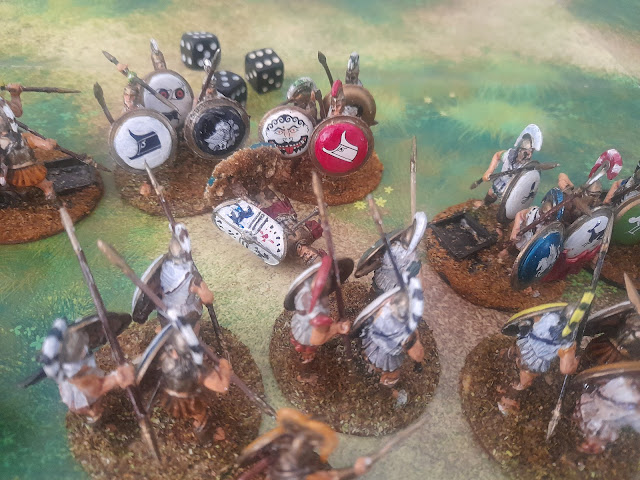Since I live in Paphos an Ancient Greek campaign was a must at some point. I am under few illusions that huge battles involving Hoplites happened in Cyprus, much less Paphos, but the Island was important for naval power in the Eastern Mediterranean.
To quote Hill in his first volume of 'The History of Cyprus': " Paphos must also have been important, although it appears but rarely in the records and the numismatic evidence is very inconclusive; it may be that the Cinyrad Dynasty priest-kings were more concerned with the cult affairs of the chief religious centre in Cyprus than with politics, although there was a Paphian contingent (which did not distinguish itself) in the fleet of Xerxes."
("did not distinguish itself" is Hill's valiant attempt to cover the fact that the Paphians lost eight out of nine ships and the last ship with only fifteen survivors ended up being captured by the Athenians)
Cyprus was not under direct Persian rule. The Empire had not created a Satrapy, and preferred instead to allow the individual Kings to rule their cities, giving allegiance to the Great King. No doubt that the idea of "divide and rule" appealed to the Persians and thus they allowed the Island kings to fight amongst themselves.
 |
| Ok so my map is pretty much a later period of Cyprus but the idea is there. |
The only ancient authority, Herodotus, describes warfare on the Island, giving a good idea of the numbers involved.
About 415 BC an adventurer, named Abdemon, probably a Phoenician from Tyre, with support from the Cypriot city of Citium, murdered the occupant of the throne of Salamis and declared himself King. Prince Euagoras the heir fled to Asia Minor. He immediately began to gather round him a small group of loyal Hoplites including Athenean Mercenaries. In 411, he returned with his warband to Cyprus, and immediately attacked a city gate at Salamis, capturing the palace from the defenders. Herodotus tells us that "Thus, taking due vengeance on his enemies, he restored the Teucrid dynasty and seated himself upon the throne of his ancestors."
One of the other comments Herodutus makes is that Euagoras attacked immediately rather than "attempting to establish himself in a strong place of any kind, and gather round him more sympathizers." This implies that the normal practice would have been nodes of hostile settlements and perhaps endemic small scale factional warfare. The emphasis on the loyalty of followers is also interesting. Cypriot cities were ruled by Kings, and in Pathos case by a Priest King, and a loyal band of supporters would be needed rather than reliance on the support of the democracy.
My Assumptions:
Hoplite warfare is ritualised and stylised. Casualties are kept to a minimum, use of missile weapons is frowned upon as "Dirty Tricks." Civilised men fight in phalanx.
In "Warfare in Ancient Greece" however Everson makes the case that the Persian and then Peloponnesian wars caused the change in Hoplite equipment to reflect the change from ritualised fighting between cities. In Cyprus, as in both Ionia, Crete and Rhodes, light troops were used more extensively.
For the numbers involved we turn to Thucydides. Hoplites were men of property between 20-50 years old. Many of these would not serve. In 231 BC with its population of 28000 Athens only had 5500 Hoplites, and this was Athens with its Empire. Boeotian cities are calculated to have had a third of the men of military age and qualification serving as Hoplites.
The population of Roman Pathos, as capital of Cyprus, was 30,000 and the Ancient population estimated to be far smaller. Looking at the size of cities populations of 5000 to 10000 are probably overestimates. With a population of 5000 a city's army cannot have been more than a few hundred strong, and drilled Hoplites even fewer in number. Now I have no intention of using 500 figures for this project. In any event a lot of these games will be little more than skirmishes.
Scenario 0. Spoils of Battle
Scenario 1: Honour the Fallen
Scenario 2: Baggage
Scenario 3: Raid and Pillage
Scenario 4: Cross the Ravine
Scenario 5: Holdout
Scenario 6: Breakthrough
Scenario 7: Face-Off
Scenario 8: Slay the Captain
Spoils of Battle
 |
| The phalanx draws up. The Tyrant Onamis attacks. |
 |
| Thrusticles shuffles forwards. |
 |
| But it's the defenders who charge home. |
 |
| It's hero vs hero |
 |
| Thrusticles shoves his enemy back. |
 |
| It all gets a bit fraught |
 |
| Onamis is pushed back. He loses three units on the bounce. |
 |
| And it's a fight over the body of Hepatitis of Kition. |
 |
| Thrusticles pushes forwards. What else! |
 |
| Game ends with the men of Salamis pushed back and surrounded. Onis flees into action. |
 |
| Thrusticles, son of Spurious, known for his sharp spear. Herodotus however points out that Thrusticles himself was not as sharp as his weapon! |

No comments:
Post a Comment